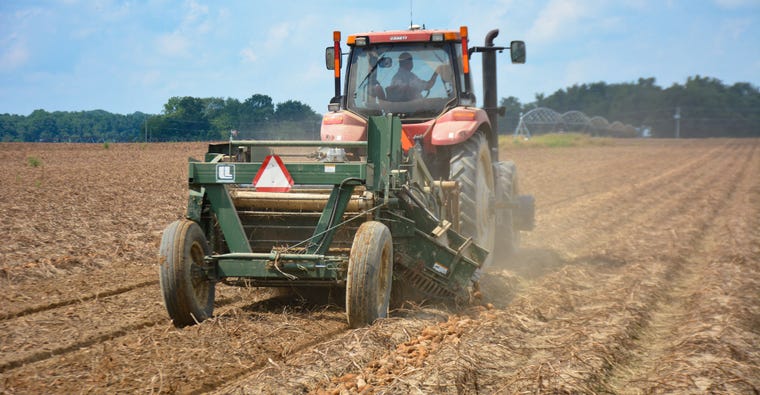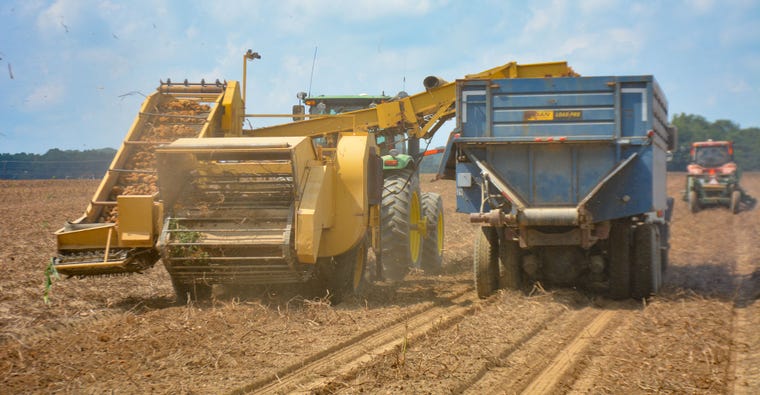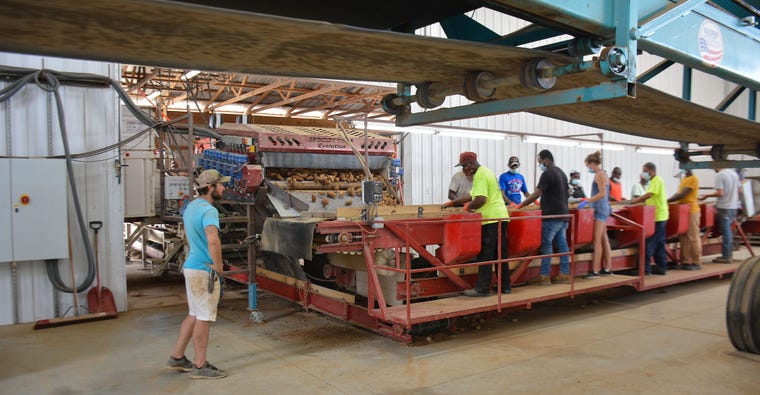When Brandon and Ashley Bonk see an opportunity to grow their business, they take it.
From 2007 to now, they’ve grown their farm in Magnolia, Del., from nothing to 5,500 acres. And while their focus is mostly on corn, soybeans and wheat, potatoes are becoming a bigger part of the business.
“Sometimes you gotta stick your neck out and try something nobody else is doing. It's a measure of risk I guess," says Brandon, who started the farm with Ashley after graduating from Iowa State University with a degree in ag systems technology.
And potatoes are an example of that. The Bonks grow around 265 acres of spuds — 40 acres for potato chips and 225 acres of table-stock varieties, including yellows, reds, whites and russets.
“We started out very small,” he says. “There’s other potato producers in the area, it appeared that they were having success with it.”
“I was good friends with a guy my age that had come from a potato farm and his family had a potato operation for 40, 50 years. I was able to work with him the first few years. I had the land; the other guy had the experience,” he says.
The two have since gone their separate ways, but Brandon and Ashley have kept growing. Delmarva, with its abundance of flat, sandy, well-drained soils, is a good area for potatoes, he says. The fields have center-pivot irrigation that keeps the potatoes hydrated over summer, but they control the water, which is key because potatoes prefer it dry.
 DIGGING ’EM OUT: A two-row potato digger picks up thousands of russet potatoes growing underground and throws them into an adjacent row where a harvester will come through and collect them.
DIGGING ’EM OUT: A two-row potato digger picks up thousands of russet potatoes growing underground and throws them into an adjacent row where a harvester will come through and collect them.

Timing is also a factor, he says. Planting potatoes happens in early spring, just before field crops are planted, and harvest falls right after wheat harvest and double-crop soybean planting, so it’s a window that works perfectly to fit them in.
"It started off as a small thing when we first started … it just sort of grown to match demand," he says. “We have a good window because there is not a lot of other areas harvesting right now. Virginia and North Carolina get their crop out before we start. Maybe some out West are producing, but we’re cheaper because of the freight.”
Starting from scratch
Brandon and Ashley both come from a farm background. Brandon’s family ran a vegetable canning and beef operation for 100 years on a farm in Sussex County, Del. He is the fifth generation of his family to farm. In 2002, his family sold the operation, but farming stayed in Brandon’s blood. He went to college in Iowa and worked on local farms while in school.
Ashley grew up on a 2,500-acre farm south of her current farm. Her father grew corn, soybeans, wheat, barley and some vegetables.
Ashley went to college to become a teacher and taught for five years, but after she and Brandon had their second child — they have four children, two boys and two girls — she decided to stay home and work on the farm.
Brandon was encouraged to come back home and start his own farm, so he first partnered in his father-in-law’s operation. Another farmer who lived farther away wanted to rent out some land that his father-in-law had available. Instead, his father-in-law offered the land to him, 225 acres, in 2007.
After several farmers decided to sell out, Brandon and Ashley started growing their acres, eventually getting to 1,000. Then, an opportunity came that they couldn’t say no to.
“So about the time we were really getting into it, the housing went bust in ’08, ’09, so land in our area became owned by banks,” he says. “Since developers couldn’t do anything with it and banks took it over, that gave use some great opportunity to buy some land.”
Land that was once sold for $40,000 to $50,000 an acre now sold for $5,000 to $6,000 an acre. Along with that, grain prices at the time were very high. “We were blessed with that opportunity,” he says. “We don’t plan very far ahead. It was an opportunity that presented itself and we thought it would work to capitalize on it.”
 CLOSER LOOK: The digger lifts out thousands of potatoes and gently places them in an adjacent row for pickup by a following harvester.
CLOSER LOOK: The digger lifts out thousands of potatoes and gently places them in an adjacent row for pickup by a following harvester.

Field crops are the moneymaker on the farm: 3,000 acres of corn, 1,500 acres of wheat and 1,000 acres of soybeans, most of which are double-cropped right after wheat.
All the corn goes to chicken feed mills on Delmarva while the soybeans, a high-oleic variety, goes to a Perdue Farms crush plant in Salisbury, Md. The wheat goes to flour mills in Pennsylvania.
Around 70% of the land is irrigated by center pivots. Most of the land he and Ashley farm is along heavily traveled Route 1, south of the Dover Air Force Base and north of Delaware’s resort beaches.
They also have 750,000 bushels of grain storage capacity.
 HARVESTING AND PICKING: The potato harvester has a dual purpose. It picks up potatoes from the picker, but it also digs up and harvests potatoes, too. Brandon Bonk says the two machines can harvest up to 125,000 pounds of potatoes in an hour.
HARVESTING AND PICKING: The potato harvester has a dual purpose. It picks up potatoes from the picker, but it also digs up and harvests potatoes, too. Brandon Bonk says the two machines can harvest up to 125,000 pounds of potatoes in an hour.

The irrigated land is strip-tilled with a cover crop growing in winter. A strip tiller runs through each spring before seeds go in the ground. Dryland corn is no-tilled into a grain cover crop, the second year they’ve done this. Wheat, radishes and clover are planted the previous fall, and the field crops, usually soybeans, are planted into it the following spring.
Secret to success
So what are the keys to their success? Having grain storage is key along with a good work ethic. The couple work many hours but also have eight full-time employees, several part-timers and seasonal H-2A workers from South Africa.
But irrigation is their biggest key to success. The couple run 45 center-pivot irrigation systems. “In our area we can grow a great crop if we can supply rainfall in the summer, and obviously irrigation is the way to do that,” he says. “It seemed like the first few years we farmed on our own, everything that wasn’t irrigated just burned up and died. I just thought that was the way it was.”
 SORTING ’EM OUT: Once out of the field, the potatoes are brought to a large shed where they are sorted before being loaded into a tractor-trailer for shipment to Pennsylvania.
SORTING ’EM OUT: Once out of the field, the potatoes are brought to a large shed where they are sorted before being loaded into a tractor-trailer for shipment to Pennsylvania.

The soils are sandy and drain well, and without irrigation, they are always days away from a drought.
“By limiting that risk … we can contract our crops and know we’re going to produce them, or feel very confident that we’re going to produce them,” he says.
Learning from others
Working with other farmers and learning from his neighbors has also been key. It’s something Brandon says other young farmers should look for if they’re unsure of how to grow the business or what they want to do.
“One of the best ways I found to do it is to look at the ways other people are doing it. They find success doing the same thing, that seems to work well, and maybe we can do it,” he says. “Just looking at other successful people and learning from them.”
"We've reached a workload and size that is well-fitted. We feel that we can manage this size well. The most important thing we can do is grow a big crop and a good crop, and market it right," he says. “So you really got to manage it for that; that's kind of how we approached it.”
About the Author(s)
You May Also Like






